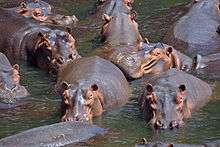Cetruminantia
The Cetruminantia are a clade made up of the Cetacodontamorpha (or Whippomorpha) and their closest living relatives, the Ruminantia.[1]
| Artiodactyla |
| ||||||||||||||||||||||||
| Cetruminantia Temporal range: Early Eocene to present | |
|---|---|
 | |
| Scientific classification | |
| Kingdom: | Animalia |
| Phylum: | Chordata |
| Class: | Mammalia |
| Order: | Artiodactyla |
| Clade: | Artiofabula |
| Clade: | Cetruminantia Waddell et al. 1999 |
| Subgroups | |
Classification
- Order Artiodactyla (even-toed ungulates)
- Tylopoda (camelids)
- Artiofabula (ruminants, pigs, peccaries, whales, and dolphins)
- Suina (pigs and peccaries)
- Cetruminantia (ruminants, whales, and dolphins)
- Suborder Ruminantia (antelope, buffalo, cattle, goats, sheep, deer, giraffes, and chevrotains)
- Family Antilocapridae (pronghorn)
- Family Bovidae, 135 species (antelope, bison, buffalo, cattle, goats, and sheep)
- Family Cervidae, 55 - 94 species (deer, elk, and moose)
- Family Giraffidae, 2 species (giraffes, okapis)
- Family Moschidae, 4 - 7 species (musk deer)
- Family Tragulidae, 6 - 10 species (chevrotains, or mouse deer)
- Suborder Whippomorpha (aquatic or semi-aquatic even-toed ungulates)
- Infraorder Acodonta
- Family Hippopotamidae, 2 species (hippopotamuses)
- Infraorder Cetacea (whales, dolphins, and porpoises)
- Mysticeti (baleen whales)
- Family Balaenidae, 2 - 4 species (right whales and bowhead whales)
- Family Balaenopteridae, 6 - 9 species (rorquals)
- Family Eschrichtiidae, 1 species (gray whale)
- Family Neobalaenidae, 1 species (pygmy right whale)
- Odontoceti (toothed whales, dolphins, and porpoises)
- Superfamily Delphinoidea (dolphins, arctic whales, porpoises, and relatives)
- Family Delphinidae, 38 species (dolphins, killer whales, and relatives)
- Family Monodontidae, 2 species (beluga and narwhal)
- Family Phocoenidae, 6 species (porpoises)
- Superfamily Physeteroidea (sperm whales)
- Family Kogiidae, 2 species (pygmy and dwarf sperm whales)
- Family Physeteridae, 1 species (common sperm whale)
- Superfamily Ziphoidea (beaked whales)
- Family Ziphidae, 22 species (modern beaked whales)
- Superfamily Platanistoidea (river dolphins)
- Family Iniidae, 1 - 3 species (South American river dolphin(s))
- Family Lipotidae, 1 species (baiji or Chinese river dolphin)
- Family Platanistidae, 1 - 2 species (Asian river dolphin(s))
- Family Pontoporiidae, 1 species (La Plata dolphin)
- Superfamily Delphinoidea (dolphins, arctic whales, porpoises, and relatives)
- Mysticeti (baleen whales)
- Infraorder Acodonta
- Suborder Ruminantia (antelope, buffalo, cattle, goats, sheep, deer, giraffes, and chevrotains)
gollark: Not entirely, no.
gollark: As technology improves this will probably get even more problematic as individual humans get able to throw around more energy to do things.
gollark: > A human gone rogue can be stopped easily enoughI mean, a hundred years ago, a rogue human might have had a gun or something, and could maybe shoot a few people before they were stopped. Nowadays, humans have somewhat easier access to chemical stuff and can probably get away with making bombs or whatever, while some control advanced weapons systems, and theoretically Trump and others have access to nukes.Also, I think on-demand commercial DNA printing is a thing now and with a few decades more development and some biology knowledge you could probably print smallpox or something?
gollark: You probably want to be able to improvise and stuff for emergencies, like in The Martian, and obviously need to be good at repair, but mostly those don't happen much.
gollark: "Oh no! We drove into a potatron warp! We need to reflux the hyperluminar subquantum transistors!"
This article is issued from Wikipedia. The text is licensed under Creative Commons - Attribution - Sharealike. Additional terms may apply for the media files.